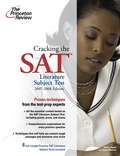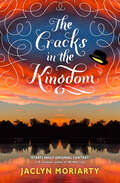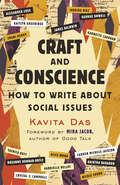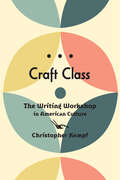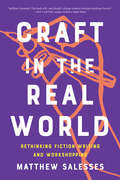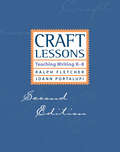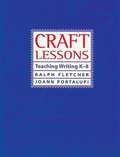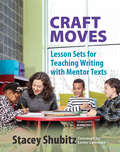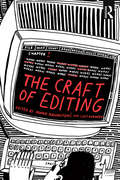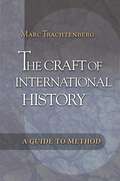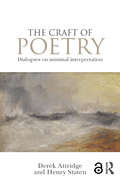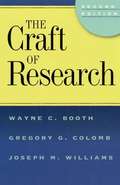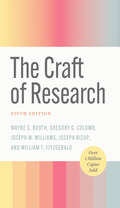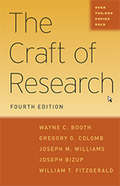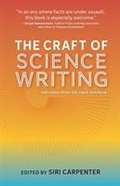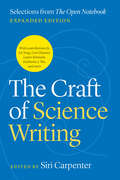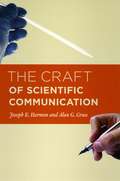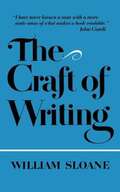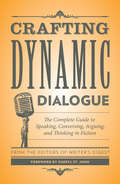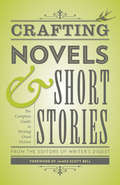- Table View
- List View
Cracking the SAT Literature Subject Test, 2007-2008 Edition
by Princeton ReviewThe Princeton Review realizes that acing the SAT Literature Subject Test is very different from earning straight A's in school. We don't try to teach you everything there is to know about literature--only the techniques and information you'll need to maximize your score. In Cracking the SAT Literature Subject Test, we'll teach you how to think like the test writers and: Learn what subject matter will be tested so you can study more effectively; Review key terms, types of literature, and reading-comprehension concepts that will help you decipher complicated questions; Use proven techniques to raise your score. The 2007-2008 edition of Cracking the SAT Literature Subject Test is revised and updated to include the most current information possible.
The Cracks in the Kingdom: Book 2 Of The Colors Of Madeleine (The Colors of Madeleine #2)
by Jaclyn MoriartyThe sequel to A Corner of White. “Mixed in with the regal intrigue is a complex, moving look at families, friendship, and loss . . . thrilling.” —School Library Journal (starred review)Picking up where A Corner of White left off, Elliot is more determined to find his father than ever, now that he knows he’s still alive. But first he must help Princess Ko find her own missing family, as the secret search for the royals of Cello begins. As part of the Royal Youth Alliance, Elliot will travel all over the Kingdom of Cello looking for any clue or detail or spell that could bring them (and maybe his own father) home. But once he learns that the royal family has been trapped in the World all this time, with no memory of their former lives, his real value to the Alliance becomes clear: He’s the only one with a connection to the World, through Madeleine.Together, through notes, letters, and late nights, Elliot and Madeleine must find a way to travel across worlds and bring missing loved ones home. The stakes are high, the writing both hilarious and heart-poundingly suspenseful, and the experience of reading it, sheer pleasure.“Madcap, whimsical, smart and even heartbreaking . . . By turns coming-of-age and wild adventure, this volume complicates the characters, expands the worldbuilding and sets things up for a grand finish in the trilogy closer . . . even better than the first.” —Kirkus Reviews (starred review)“Full of clever invention and intrigue, excellent surprises, and all the sophisticated wit Moriarty’s fans expect.” —The Horn Book (starred review)
Cradle of Liberty: Race, the Child, and National Belonging from Thomas Jefferson to W. E. B. Du Bois
by Caroline F. LevanderThroughout American literature, the figure of the child is often represented in opposition to the adult. In Cradle of Liberty Caroline F. Levander proposes that this opposition is crucial to American political thought and the literary cultures that surround and help produce it. Levander argues that from the late eighteenth century through the early twentieth, American literary and political texts did more than include child subjects: they depended on them to represent, naturalize, and, at times, attempt to reconfigure the ground rules of U. S. national belonging. She demonstrates how, as the modern nation-state and the modern concept of the child (as someone fundamentally different from the adult) emerged in tandem from the late eighteenth century forward, the child and the nation-state became intertwined. The child came to represent nationalism, nation-building, and the intrinsic connection between nationalism and race that was instrumental in creating a culture of white supremacy in the United States. Reading texts by John Adams, Thomas Paine, Harriet Beecher Stowe, Augusta J. Evans, Mark Twain, Pauline Hopkins, William James, Jos Mart, W. E. B. Du Bois, and others, Levander traces the child as it figures in writing about several defining events for the United States. Among these are the Revolutionary War, the U. S. -Mexican War, the Civil War, and the U. S. expulsion of Spain from the Caribbean and Cuba. She charts how the child crystallized the concept of self--a self who could affiliate with the nation--in the early national period, and then follows the child through the rise of a school of American psychology and the period of imperialism. Demonstrating that textual representations of the child have been a potent force in shaping public opinion about race, slavery, exceptionalism, and imperialism, Cradle of Liberty shows how a powerful racial logic pervades structures of liberal democracy in the United States.
Craft and Conscience: How to Write About Social Issues
by Kavita DasThe first major book for writers to more effectively engage with complex socio-political issues—a critical first step in creating social changeWriters are witnesses and scribes to society's conscience but writing about social issues in the twenty-first century requires a new, sharper toolkit. Craft and Conscience helps writers weave together their narrative craft, analytical and research skills, and their conscience to create prose which makes us feel the individual and collective impact of crucial issues of our time. Kavita Das guides writers to take on nuanced perspectives and embrace intentionality through a social justice lens. She challenges writers to unpack their motivations for writing about an issue and to understand that &“writing, irrespective of genre or outlet, is an act of political writing,&” regardless of intention. The book includes essays from a fascinating mix of authors, including James Baldwin, Alexander Chee, Kaitlyn Greenidge, George Orwell, Roxanne Dunbar-Ortiz, Gaiutra Bahadur, Jaquira Díaz, and Imani Perry. By including Das&’s own perspective and those of the featured writers about motivations and approaches to writing about fraught social issues, this book both demystifies the process of engaging social issues on the page, and underscores the intentionality and sensitivity that must go into the work.
Craft Class: The Writing Workshop in American Culture
by Christopher KempfThe hidden history of the creative writing workshop and the socioeconomic consequences of the craft labor metaphor.In a letter dated September 1, 1912, drama professor George Pierce Baker recommended the term "workshop" for an experimental course in playwriting he had been planning with former students at Harvard and Radcliffe. This was the first time that term, now ubiquitous, was used in the context of creative writing pedagogy. Today, the MFA (master of fine arts) industry is a booming one, with more than 200 programs and thousands of residencies and conferences for aspiring writers nationwide. Almost all of these offerings operate on the workshop model.In Craft Class, Christopher Kempf argues that the primary institutional form of creative writing studies, the workshop, has remained invisible before our scholarly eyes. While Baker and others marshaled craft toward economic critique, craft pedagogies consolidated the authority of elite educational institutions as the MFA industry grew. Transcoding professional-managerial soft skills—linguistic facility, social and emotional discernment, symbolic fluency—in the language of manual labor, the workshop nostalgically invokes practices that the university itself has rendered obsolete. The workshop poem or short story thus shares discursive space with the craft IPA or hand-loomed Pottery Barn rug—a space in which one economic practice rewrites itself in the language of another, just as right-wing corporatism continuously rewrites itself in the language of populism.Delineating an arc that extends from Boston's fin de siècle Society of Arts and Crafts through 1930s proletarian workshops to the pedagogies of Black Mountain College and the postwar MFA, Craft Class reveals how present-day creative writing restructures transhistorical questions of labor, education, and aesthetic and economic production. With the rise of the workshop in American culture, Kempf shows, manual and mental labor have been welded together like steel plates. What fissures does that weld seal shut? And on whose behalf does the poet punch in?
Craft in the Real World: Rethinking Fiction Writing and Workshopping
by Matthew SalessesThis national bestseller is "a significant contribution to discussions of the art of fiction and a necessary challenge to received views about whose stories are told, how they are told and for whom they are intended" (Laila Lalami, The New York Times Book Review).The traditional writing workshop was established with white male writers in mind; what we call craft is informed by their cultural values. In this bold and original examination of elements of writing—including plot, character, conflict, structure, and believability—and aspects of workshop—including the silenced writer and the imagined reader—Matthew Salesses asks questions to invigorate these familiar concepts. He upends Western notions of how a story must progress. How can we rethink craft, and the teaching of it, to better reach writers with diverse backgrounds? How can we invite diverse storytelling traditions into literary spaces? Drawing from examples including One Thousand and One Nights, Curious George, Ursula K. Le Guin's A Wizard of Earthsea, and the Asian American classic No-No Boy, Salesses asks us to reimagine craft and the workshop. In the pages of exercises included here, teachers will find suggestions for building syllabi, grading, and introducing new methods to the classroom; students will find revision and editing guidance, as well as a new lens for reading their work. Salesses shows that we need to interrogate the lack of diversity at the core of published fiction: how we teach and write it. After all, as he reminds us, "When we write fiction, we write the world."
Craft Lessons: Teaching Writing K-8
by Ralph Fletcher JoAnn PortalupiSince its publication in 1998 Craft Lessons has become a staple in the writing classroom of both new and experienced teachers. Authors Ralph Fletcher and JoAnn Portalupi recognized the need for a succinct resource and teamed together to write the second edition of Craft Lessons: Teaching Writing K-8 . Teachers pressed for time will appreciate the practical lessons and instructional language geared to three grade level groupings: K-2, 3-4, and 5-8. This edition includes: 17 brand new lessons; mini lessons designed from teachers&’ comments about what is observed students&’ writing Revisions to other craft lessons and the resource materials sections have been expanded New ways to approach teaching using elements of craft and the reading-writing connection A subject index to find specific craft lessons with ease The authors&’ thoughts about how craft lessons fit into their newest thinking about the qualities of writing: Ideas, Design, Language, and Presentation The 95 lessons in this book provide a wealth of information for teaching leads, character, endings, stronger verbs, and much more. This new edition reestablishes Craft Lessons as the crucial desert island book for harried writing teachers everywhere
Craft Lessons: Teaching Writing K-8
by Joann Portalupi Ralph FletcherCraft is the cauldron in which the writing gets forged. Ralph Fletcher and JoAnn Portalupi argue that too often we concentrate on the beginning and ending of the writing process--conceiving and correcting--while leaving students on their own to make a thousand critical decisions in their writing about crafting leads, voice, structure, supporting detail, setting, mood, and character. What elements of craft can we teach student writers, and at what age are they ready to learn them? This book answers both questions. Craft Lessons is the practical text for the over-scheduled writing teacher who wants to give students fresh challenges for their writing but doesn't have time to pore over dozens of trade books to do so. There are three main sections in the book: one geared for teachers of primary students, one for teachers of grades 3-4, and one for teachers of middle school writers. This developmental structure allows teachers to go directly to those craft lessons most applicable and adaptable to their own students. Each of the 78 lessons is presented on a single page in an easy-to-read format.
Craft Moves: Lesson Sets for Teaching Writing with Mentor Texts
by Stacey ShubitzHow do you choose mentor texts for your students? How do you mine them for the craft lessons you want your students to learn?In Craft Moves: Lesson Sets for Teaching Writing with Mentor Texts , Stacey Shubitz, co-founder of the Two Writing Teachers website, usestwenty recently published picture books to createmore than 180 lessons to teach various craft moves that will help your students become better writers.Each of the 184 lessons in the book includes a publisher's summary, a rationale or explanation of the craft move demonstrated in the book, and a procedure that takes teachers and students back into the mentor text to deepen their understanding of the selected craft move. A step-by-step guide demonstrates how to analyze a picture book for multiple craft moves.Shubitzintroduces picture books as teaching tools and offers ways to integrate them into your curriculum and classroom discussions. She then shares different routines and classroom procedures designed to help students focus on their writing during the writer's workshop as well as focusing how teachers can prepare for small group instruction.Using picture books as mentor texts will help your students not only read as writers and write with joy but also become writers who can effectively communicate meaning, structure their writing, write with detail, and give their writing their own unique voice.
The Craft of Criticism: Critical Media Studies in Practice
by Michael Kackman Mary Celeste KearneyWith contributions from 30 leading media scholars, this collection provides a comprehensive overview of the main methodologies of critical media studies. Chapters address various methods of textual analysis, as well as reception studies, policy, production studies, and contextual, multi-method approaches, like intertextuality and cultural geography. Film and television are at the heart of the collection, which also addresses emergent technologies and new research tools in such areas as software studies, gaming, and digital humanities. Each chapter includes an intellectual history of a particular method or approach, a discussion of why and how it was used to study a particular medium or media, relevant examples of influential work in the area, and an in-depth review of a case study drawn from the author's own research. Together, the chapters in this collection give media critics a complete toolbox of essential critical media studies methodologies.
The Craft of Editing
by Adnan Mahmutović Lucy DurneenThe Craft of Editing offers a rare insight into the unique dynamic between author and editor. In this illuminating book, Adnan Mahmutović and Lucy Durneen lead a cohort of industry experts to bring transparency to the mystique that often surrounds the craft and practice of editing. Using genuine case studies from published works – including annotated manuscripts – this book prepares writers for potential dialogue and critique from editors. The Craft of Editing follows the journey from rough draft to publication, an essential part of any writing experience, while showing the singular and authentic approach each editor takes. Using original pitches, debates, emails, and instant messages to shed light on the collaboration between authors and editors, The Craft of Editing is an indispensable tool to creative writers and students alike.
The Craft of Historical Research: A Practical Guide from Start to Finish
by Isaac LandComplete with practical advice and helpful guidance, this book is an approachable manual perfect for budding historians at all levels. Its worksheets, which focus on framing realistic goals and heading off common misunderstandings, will aid independent work and make check-ins with the advisor more candid and productive. Drawing on examples from six continents, as well as primary sources ranging from cuneiform tablets to emails, students will learn about the effective deployment of quotations, footnotes, maps, graphs, images, and data visualizations. Throughout the book, emphasis is placed on how the student can formulate, support, and revise their claims in a historical project with a skeptical reader in mind.
The Craft of International History: A Guide to Method
by Marc TrachtenbergThis is a practical guide to the historical study of international politics. The focus is on the nuts and bolts of historical research--that is, on how to use original sources, analyze and interpret historical works, and actually write a work of history. Two appendixes provide sources sure to be indispensable for anyone doing research in this area. The book does not simply lay down precepts. It presents examples drawn from the author's more than forty years' experience as a working historian. One important chapter, dealing with America's road to war in 1941, shows in unprecedented detail how an interpretation of a major historical issue can be developed. The aim throughout is to throw open the doors of the workshop so that young scholars, both historians and political scientists, can see the sort of thought processes the historian goes through before he or she puts anything on paper. Filled with valuable examples, this is a book anyone serious about conducting historical research will want to have on the bookshelf.
The Craft of Poetry: Dialogues on Minimal Interpretation
by Derek Attridge Henry StatenThis book presents an innovative format for poetry criticism that its authors call "dialogical poetics." This approach shows that readings of poems, which in academic literary criticism often look like a product of settled knowledge, are in reality a continual negotiation between readers. But Derek Attridge and Henry Staten agree to rein in their own interpretive ingenuity and "minimally interpret" poems – reading them with careful regard for what the poem can be shown to actually say, in detail and as a whole, from opening to closure. Based on a series of emails, the book explores a number of topics in the reading of poetry, including historical and intellectual context, modernist difficulty, the role of criticism, and translation. This highly readable book will appeal to anyone who enjoys poetry, offering an inspiring resource for students whilst also mounting a challenge to some of the approaches to poetry currently widespread in the academy.
The Craft Of Research
by Wayne Booth Gregory G. Colomb Joseph M. WilliamsSince 1995, more than 150,000 students and researchers have turned to The Craft of Research for clear and helpful guidance on how to conduct research and report it effectively . Now, master teachers Wayne C. Booth, Gregory G. Colomb, and Joseph M. Williams present a completely revised and updated version of their classic handbook. <p><p> Like its predecessor, this new edition reflects the way researchers actually work: in a complex circuit of thinking, writing, revising, and rethinking. It shows how each part of this process influences the others and how a successful research report is an orchestrated conversation between a researcher and a reader. Along with many other topics, The Craft of Research explains how to build an argument that motivates readers to accept a claim; how to anticipate the reservations of thoughtful yet critical readers and to respond to them appropriately; and how to create introductions and conclusions that answer that most demanding question, "So what?" <p> Celebrated by reviewers for its logic and clarity, this popular book retains its five-part structure. Part 1 provides an orientation to the research process and begins the discussion of what motivates researchers and their readers. Part 2 focuses on finding a topic, planning the project, and locating appropriate sources. This section is brought up to date with new information on the role of the Internet in research, including how to find and evaluate sources, avoid their misuse, and test their reliability. <p> Part 3 explains the art of making an argument and supporting it. The authors have extensively revised this section to present the structure of an argument in clearer and more accessible terms than in the first edition. New distinctions are made among reasons, evidence, and reports of evidence. The concepts of qualifications and rebuttals are recast as acknowledgment and response. Part 4 covers drafting and revising, and offers new information on the visual representation of data. Part 5 concludes the book with an updated discussion of the ethics of research, as well as an expanded bibliography that includes many electronic sources. <p> The new edition retains the accessibility, insights, and directness that have made The Craft of Research an indispensable guide for anyone doing research, from students in high school through advanced graduate study to businesspeople and government employees. The authors demonstrate convincingly that researching and reporting skills can be learned and used by all who undertake research projects. <p> New to this edition: <p> Extensive coverage of how to do research on the internet, including how to evaluate and test the reliability of sources <p> New information on the visual representation of data <p> Expanded bibliography with many electronic sources
The Craft of Research (3rd edition)
by Wayne C. Booth Gregory G. Colomb Joseph M. WilliamsWith more than 200,000 copies in print, The Craft of Research is the unrivaled resource for researchers at every level, from first-year undergraduates to research reporters at corporations and government offices. Now, seasoned researchers and educators Gregory G. Colomb and Joseph M. Williams present an updated third edition of their classic handbook, whose first and second editions were written in collaboration with the late Wayne C. Booth. The Craft of Research explains how to build an argument that motivates readers to accept a claim; how to anticipate the reservations of readers and to respond to them appropriately; and how to create introductions and conclusions that answer that most demanding question, "So what?"
The Craft of Research, Fifth Edition (Chicago Guides to Writing, Editing, and Publishing)
by Joseph M. Williams Wayne C. Booth Gregory G. Colomb Joseph Bizup William T. FitzGeraldA thoroughly updated edition of a beloved classic that has guided generations of researchers in conducting effective and meaningful research. With more than a million copies sold since its first publication, The Craft of Research has helped generations of researchers at every level—from high-school students and first-year undergraduates to advanced graduate students to researchers in business and government. Conceived by seasoned researchers and educators Wayne C. Booth, Gregory G. Colomb, and Joseph M. Williams, this fundamental work explains how to choose significant topics, pose genuine and productive questions, find and evaluate sources, build sound and compelling arguments, and convey those arguments effectively to others. While preserving the book’s proven approach to the research process, as well as its general structure and accessible voice, this new edition acknowledges the many ways research is conducted and communicated today. Thoroughly revised by Joseph Bizup and William T. FitzGerald, it recognizes that research may lead to a product other than a paper—or no product at all—and includes a new chapter about effective presentations. It features fresh examples from a variety of fields that will appeal to today’s students and other readers. It also accounts for new technologies used in research and offers basic guidelines for the appropriate use of generative AI. And it ends with an expanded chapter on ethics that addresses researchers’ broader obligations to their research communities and audiences as well as systemic questions about ethical research practices. This new edition will be welcomed by a new and more diverse generation of researchers.
The Craft of Research, Fourth Edition (Chicago Guides to Writing, Editing, and Publishing)
by Joseph M. Williams Wayne C. Booth Gregory G. Colomb Joseph Bizup William T. FitzgeraldWith more than three-quarters of a million copies sold since its first publication, The Craft of Research has helped generations of researchers at every level--from first-year undergraduates to advanced graduate students to research reporters in business and government--learn how to conduct effective and meaningful research. Conceived by seasoned researchers and educators Wayne C. Booth, Gregory G. Colomb, and Joseph M. Williams, this fundamental work explains how to find and evaluate sources, anticipate and respond to reader reservations, and integrate these pieces into an argument that stands up to reader critique. The fourth edition has been thoroughly but respectfully revised by Joseph Bizup and William T. FitzGerald. It retains the original five-part structure, as well as the sound advice of earlier editions, but reflects the way research and writing are taught and practiced today. Its chapters on finding and engaging sources now incorporate recent developments in library and Internet research, emphasizing new techniques made possible by online databases and search engines. Bizup and FitzGerald provide fresh examples and standardized terminology to clarify concepts like argument, warrant, and problem. Following the same guiding principle as earlier editions--that the skills of doing and reporting research are not just for elite students but for everyone--this new edition retains the accessible voice and direct approach that have made The Craft of Research a leader in the field of research reference. With updated examples and information on evaluation and using contemporary sources, this beloved classic is ready for the next generation of researchers.
The Craft of Science Writing: Selections from The Open Notebook
by Siri CarpenterThis book is a collection of indispensable articles on the craft of science writing as told by some of the most skillful science journalists working today. These selections are a wealth of journalistic knowledge from The Open Notebook, the online community that has been a primary resource for science journalists and aspiring science writers for the last decade. The Craft of Science Writing gives you a crew of accomplished, encouraging friends to whisper over your shoulder as you work. In these pages, you'll find interviews with leading journalists offering behind-the-scenes inspiration, as well as in-depth essays on the craft offering practical advice.
The Craft of Science Writing: Selections from “The Open Notebook,” Expanded Edition (Chicago Guides to Writing, Editing, and Publishing)
by Siri CarpenterA deeply sourced, inclusive guide to all aspects of science writing with contributions from some of the most skilled and award-winning authors working today. Science writing has never been so critical to our world, and the demands on writers have never been greater. On any given day, a writer might need to explain the details of AI, analyze developments in climate change research, or serve as a watchdog helping to ensure the integrity of the scientific enterprise. At the same time, writers must spin tales that hook and keep readers, despite the endless other demands on their attention. How does one do it? The Craft of Science Writing is the authoritative guide. With pieces curated from the archives of science writers’ go-to online resource, The Open Notebook, this book explores strategies for finding and shaping story ideas, pitching editors, and building a specialty in science writing. It delves into fundamental skills that every science writer must learn, including planning their reporting; identifying, interviewing, and quoting sources; organizing interview notes; and crafting stories that engage and inform audiences. This expanded edition includes new introductory material and nine new essays focusing on such topics as how to establish a science beat, how to find and use quotes, how to critically evaluate scientific claims, how to use social media for reporting, and how to do data-driven reporting. In addition, there are essays on inclusivity in science writing, offering strategies for eradicating ableist language from stories, working with sensitivity readers, and breaking into English-language media for speakers of other languages. Through interviews with leading journalists offering behind-the-scenes inspiration as well as in-depth essays on the craft offering practical advice, readers will learn how the best science stories get made, from conception to completion. Contributors: Humberto Basilio, Siri Carpenter, Jeanne Erdmann, Dan Ferber, Tina Casagrand Foss, Geoffrey Giller, Laura Helmuth, Jane C. Hu, Alla Katsnelson, Roxanne Khamsi, Betsy Ladyzhets, Jyoti Madhusoodanan, Amanda Mascarelli, Robin Meadows, Kate Morgan, Tiên Nguyễn, Michelle Nijhuis, Aneri Pattani, Rodrigo Pérez Ortega, Mallory Pickett, Kendall Powell, Tasneem Raja, Sandeep Ravindran, Marion Renault, Julia Rosen, Megha Satyanarayana, Christina Selby, Knvul Sheikh, Abdullahi Tsanni, Alexandra Witze, Katherine J. Wu, Wudan Yan, Ed Yong, Rachel Zamzow, Sarah Zhang, and Carl Zimmer
The Craft of Scientific Communication (Chicago Guides To Writing, Editing, And Ser.)
by Alan G. Gross Joseph E. HarmonThe ability to communicate in print and person is essential to the life of a successful scientist. But since writing is often secondary in scientific education and teaching, there remains a significant need for guides that teach scientists how best to convey their research to general and professional audiences. The Craft of Scientific Communication will teach science students and scientists alike how to improve the clarity, cogency, and communicative power of their words and images.In this remarkable guide, Joseph E. Harmon and Alan G. Gross have combined their many years of experience in the art of science writing to analyze published examples of how the best scientists communicate. Organized topically with information on the structural elements and the style of scientific communications, each chapter draws on models of past successes and failures to show students and practitioners how best to negotiate the world of print, online publication, and oral presentation.
The Craft Of Writing
by William SloaneA writer, editor, publisher, and teacher, Sloane presents his ideas on writing and on teaching the craft of writing in chapters derived chiefly from lectures presented at the Bread Loaf Writers' Conference.
Crafting Category Romance - The Art of Fiction Haiku: The Art Of Fiction Haiku
by Amy LaneCategory romance is a precise art. With such a small word count, writing the perfect category romance is a little like writing a haiku. But how do you write a book in seventeen syllables? How can you cram compelling conflict, satisfying character development, and toe-curling romantic tension into less than sixty thousand words? In Crafting Category Romance, two-time RITA™-nominated author of nearly one hundred books Amy Lane describes the rules of engagement, traps to watch out for, and how to leverage common tropes to create conflict, craft a character, develop a plot, and leave readers with a happy ever after that's different every time—all in a tidy package. With practical exercises in plot, conflict, and character development, Crafting Category Romance will teach you how to use the rigid rules and expectations of the genre to your advantage and win a loyal readership following for life.
Crafting Dynamic Dialogue: The Complete Guide to Speaking, Conversing, Arguing, and Thinking in Fiction (Creative Writing Essentials)
by Cheryl St. John Writer's Digest EditorsWrite authentic dialogue that invigorates your story! Exceptional dialogue isn't just important when writing fiction--it's essential. In order to impress an agent or editor and keep readers turning pages, you need to deliver truly standout dialogue in every scene. Crafting Dynamic Dialogue will give you the techniques and examples you need to impress your readers. This book is a comprehensive guide to writing compelling dialogue that rings true. Each section is packed with advice and instruction from best-selling authors and instructors like Nancy Kress, Elizabeth Sims, Steven James, Deborah Halverson, James Scott Bell, Donald Maass, Cheryl St. John, and many others. They'll show you how to:Bend the rules to create a specific effectUnderstand the role of dialogue in reader engagementUse dialect and jargon effectivelyGive every character a believable, unique voiceSet the pace and toneReveal specific character background detailsGenerate tension and suspenseUtilize internal dialogueWhether you're writing flash fiction, a short story, or a novel-length manuscript, Crafting Dynamic Dialogue will help you develop, write, and refine dialogue to keep your readers hooked.
Crafting Novels & Short Stories: The Complete Guide to Writing Great Fiction (Creative Writing Essentials)
by Editors of Writer's DigestLearn How to Create Stories That Captivate Agents, Editors, and Readers Alike! Inside you'll find the tools you need to build strong characters, keep your plots moving, master the art of dialogue, choose the right point of view, and more. This comprehensive book on the art of novel and short story writing is packed with advice and instruction from best-selling authors and writing experts like Nancy Kress, Elizabeth Sims, Hallie Ephron, N.M. Kelby, Heather Sellers, and Donald Maass, plus a foreword by James Scott Bell. You'll learn invaluable skills for mastering every area of the craft: Define and refine your characters. Make your plot and conflict high-energy and intense. Hone your story's point of view. Create a rich setting and backstory. Craft dialogue that rings true. Select the right words and descriptions throughout your story. Revise your story to perfection. Throughout you'll find supplemental sections that cover special topics like getting started, beating writer's block, researching your work, and getting published. They'll help you integrate your skills into a balanced, productive, and fulfilling career. Whether you're writing flash fiction, a short story, a novel, or an epic trilogy, you'll come away with the tools you need for strong and effective storytelling.
